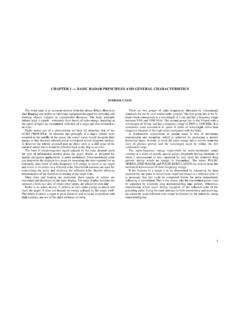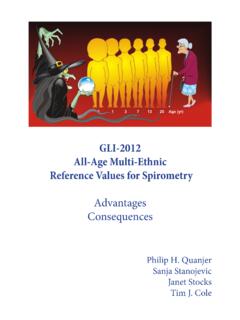Transcription of CHAPTER 4 SAMPLE DESIGN TARGET POPULATION AND …
1 1 CHAPTER 4 SAMPLE DESIGN TARGET POPULATION AND OVERVIEW OF THE SAMPLING DESIGN The desired base PISA TARGET POPULATION in each country consisted of 15-year-old students attending educational institutions in grades 7 and higher. This meant that countries were to include: 15-year-olds enrolled full-time in educational institutions; 15-year-olds enrolled in educational institutions who attended only on a part-time basis; students in vocational training programmes, or any other related type of educational programmes; and students attending foreign schools within the country (as well as students from other countries attending any of the programmes in the first three categories). It was recognised that no testing of 15-year-olds schooled in the home, workplace or out of the country would occur and therefore these 15-year-olds were not included in the international TARGET POPULATION .
2 The operational definition of an age POPULATION directly depends on the testing dates. The international requirement was that the assessment had to be conducted during a 42-day period, referred to as the testing period, between 1 March 2015 and 31 August 2015, unless otherwise agreed. Further, testing was not permitted during the first six weeks of the school year because of a concern that student performance levels may have been lower at the beginning of the academic year than at the end of the previous academic year, even after controlling for age. The 15-year-old international TARGET POPULATION was slightly adapted to better fit the age structure of most of the Northern Hemisphere countries. As the majority of the testing was planned to occur in April, the international TARGET POPULATION was consequently defined as all students aged from 15 years and 3 completed months to 16 years and 2 completed months at the beginning of the assessment period.
3 This meant that in all countries testing in April 2015, the TARGET POPULATION could have been defined as all students born in 1999 who were attending an educational institution as defined above. A variation of up to one month in this age definition was permitted. This allowed a country testing in March or in May to still define the national TARGET POPULATION as all students born in 1999. If the testing was to take place between June and December, the birth date definition had to be adjusted 2 so that in all countries the TARGET POPULATION was always students aged 15 years and 3 completed months to 16 years and 2 completed months at the time of testing, or a one month variation of this. In all but one country, the Russian Federation, the sampling DESIGN used for the PISA assessment was a two-stage stratified SAMPLE DESIGN .
4 The first-stage sampling units consisted of individual schools having 15-year-old students, or the possibility of having such students at the time of assessment. Schools were sampled systematically from a comprehensive national list of all PISA-eligible schools, known as the school sampling frame, with probabilities that were proportional to a measure of size. The measure of size was a function of the estimated number of PISA-eligible 15-year-old students enrolled in the school. This is referred to as systematic Probability Proportional to Size (PPS) sampling. Prior to sampling, schools in the sampling frame were assigned to mutually exclusive groups based on school characteristics called explicit strata, formed to improve the precision of SAMPLE -based estimates.
5 The second-stage sampling units in countries using the two-stage DESIGN were students within sampled schools. Once schools were selected to be in the SAMPLE , a complete list of each sampled school s 15-year-old students was prepared. For each country a TARGET Cluster Size (TCS) was set; this value was typically 42 students for computer-based countries and 35 for paper-based countries, although with agreement countries could use alternative values. The SAMPLE size within schools is prescribed, within limits, in the PISA Technical Standards (see Annex F). From each list of students that contained more than the TCS, a SAMPLE of typically 42 students were selected with equal probability and for lists of fewer than the TCS, all students on the list were selected.
6 For countries participating in the International Option of Financial Literacy (FL), the TCS remained the same, as the students selected for FL in 2015 were a subsample of the students sampled for the regular PISA test (see CHAPTER 2). In the Russian Federation, a three-stage DESIGN was used. In this case, geographical areas were sampled first (first-stage units) using probability proportional to size sampling, and then schools (second-stage units) were selected within these sampled geographical areas. Students were the third-stage sampling units in this three-stage DESIGN and were sampled from the selected schools. POPULATION COVERAGE, AND SCHOOL AND STUDENT PARTICIPATION RATE STANDARDS To provide valid estimates of student achievement, the SAMPLE of students had to be selected using established and professionally recognised principles of scientific sampling, in a way that ensured representation of the full TARGET POPULATION of 15-year-old students in the participating countries.
7 Furthermore, quality standards had to be maintained with respect to (i) the coverage of the PISA international TARGET POPULATION , (ii) accuracy and precision, and (iii) the school and student response rates. 3 Coverage of the PISA international TARGET POPULATION National Project Managers (NPMs) might have found it necessary to reduce their coverage of the TARGET POPULATION by excluding, for instance, a small, remote geographical region due to inaccessibility, or a language group, possibly due to political, organisational or operational reasons, or special education needs students. Areas deemed to be part of a country (for the purpose of PISA), but which were not included for sampling, although this occurred infrequently, were designated as non-covered areas.
8 Care was taken in this regard because, when such situations did occur, the national desired TARGET POPULATION differed from the international desired TARGET POPULATION . In an international survey in education, the types of exclusion must be defined consistently for all participating countries and the exclusion rates have to be limited. Indeed, if a significant proportion of students were excluded, this would mean that survey results would not be deemed representative of the entire national school system. Thus, efforts were made to ensure that exclusions, if they were necessary, were minimised according to the PISA 2015 Technical Standards (see Appendix F). Exclusion can also take place either at the school level (exclusion of entire schools) often for Special Education Needs (SEN) schools or language schools, or at the within-school level (exclusion of individual students), most often for SEN needs or language.
9 International within-school exclusion rules for students were specified as follows: Intellectually disabled students are students who have a mental or emotional disability and who, in the professional opinion of qualified staff, are cognitively delayed such that they cannot be validly assessed in the PISA testing setting. This category includes students who are emotionally or mentally unable to follow even the general instructions of the test. Students were not to be excluded solely because of poor academic performance or normal discipline problems. Functionally disabled students are students who are permanently physically disabled in such a way that they cannot be validly assessed in the PISA testing setting. However, functionally disabled students who could provide responses were to be included in the testing.
10 Students with insufficient assessment language experience are students who need to meet all of the following criteria: i) are not native speakers of the assessment language(s), ii) have limited proficiency in the assessment language(s), and iii) have received less than one year of instruction in the assessment language(s). Students with insufficient assessment language experience could be excluded. Students not assessable for other reasons as agreed upon. A nationally-defined within-school exclusion category was permitted if agreed upon by the International Contractor. A specific subgroup of students (for example students with severe dyslexia, dysgraphia, or dyscalculia) could be identified for whom exclusion was necessary but for whom the previous three within-school exclusion categories did not explicitly apply, so that a more specific within-school exclusion definition was needed.

















